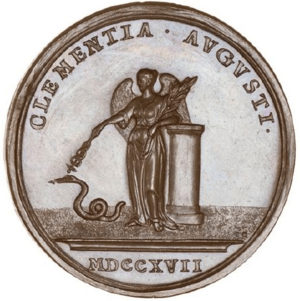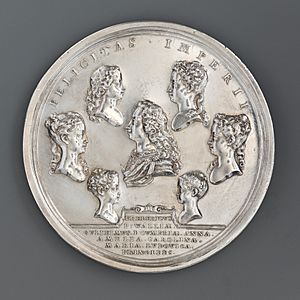John Croker (engraver) facts for kids
John Croker (born October 21, 1670 – died March 21, 1741) was a very skilled jeweller. He was born in a place called Saxony, which is now part of Germany. When he was young, people knew him as Johann Crocker. He moved to London, England, and became a famous medallist. A medallist is someone who designs and makes special coins and medals.
For most of his life, Croker worked in England. He made the special tools (called dies) for English and later British coins and medals. He worked at the Royal Mint, which is where coins are made. He even worked closely with the famous scientist, Isaac Newton, who was in charge of the Mint! John Croker was the Chief Engraver at the Royal Mint from 1705 until he passed away.
Contents
John Croker's Early Life and Career
John Croker was born in Dresden in 1670. His father was a cabinet-maker for a local ruler. Sadly, his father died when John was very young. After that, he became an apprentice to his godfather, who was a goldsmith and jeweller in Dresden. An apprentice learns a trade from a skilled master.
After finishing his training, John Croker moved to the Netherlands. Then, in 1691, he moved to England. In England, he worked for a jeweller and started making medals. He changed his name to "John Croker" to sound more English.
Becoming Chief Engraver
In 1697, John Croker became an assistant to Henry Harris, who was the chief engraver at the Royal Mint. When Harris died in 1704, Croker asked Lord Godolphin, a very important government official, if he could take over the job.
Croker explained that he had already been making the tools for coins at the Tower of London Mint and five other mints for seven years. The people at the Mint agreed that he was the best choice. So, on April 7, 1705, he became the Chief Engraver. That same year, he got married, but his only daughter died when she was a child.
Making Medals and Coins
Soon after becoming Chief Engraver, Croker was allowed to make medals on his own. This helped him keep his engraving skills sharp. One of his famous medals celebrates the Act of Grace of 1717. This act set hundreds of people free who had been involved in a rebellion.
This medal shows King George I on one side. On the other side, it shows a winged figure representing "Clemency" (which means mercy). She holds an olive branch and a caduceus, touching a fleeing snake. The snake stands for the rebellion.
John Croker made almost all the coin dies for Queen Anne and King George I. He also made many for George II until 1740. He created many beautiful medals too. In 1729, the head of the Mint worried that Croker was the only person who could make the special tools for the king's head on coins. So, they hired a young assistant named John Sigismund Tanner to learn from him.
Croker's wife passed away in 1735. He stayed healthy and had good eyesight until his last two years. Even when he was getting older, he still did some engraving. He also enjoyed reading in his free time. John Croker died on March 21, 1741, and his assistant, Tanner, took over his important job.
Famous Medals by John Croker
John Croker created many important medals. These medals often celebrated big events in British history, like peace treaties, battles, or royal coronations. Here are some of his main medals:
- State of Britain after Peace of Ryswick, 1697
- Accession (when a new ruler takes the throne), 1702
- Coronation (official medal for Queen Anne), 1702
- Anne and Prince George of Denmark, 1702
- Expedition to Vigo Bay (a battle), 1702
- Capitulation of Towns on the Meuse (towns surrendering), 1702
- Cities captured by Marlborough (a famous general), 1703
- Queen Anne's Bounty (a special fund), 1704
- Battle of Blenheim, 1704
- Capture of Gibraltar, 1704
- Barcelona relieved, 1706
- Battle of Ramillies, 1706
- Union of England and Scotland (when they became Great Britain), 1707
- Battle of Oudenarde, 1708
- Capture of Sardinia and Minorca, 1708
- Citadel of Lille taken, 1708
- City of Tournay taken, 1709
- Battle of Malplaquet, 1709
- Douay taken, 1710
- Battle of Almenara, 1710
- The French lines passed, and Bouchain taken, 1711
- Peace of Utrecht, 1713
- Medallic portrait of Queen Anne
- Arrival of George in England, 1714
- Entry into London, 1714
- Coronation (official medal for King George I), 1714
- Battle of Sheriffmuir, 1715
- Preston taken, 1715
- Act of Grace (pictured above), 1717
- Treaty of Passarowitz, 1718
- Naval Action off Cape Passaro, 1718
- Caroline, Princess of Wales, 1718
- Order of the Bath revived (a special honour), 1725
- Sir Isaac Newton, 1726
- Coronation of George II (official medal), 1727
- Queen Caroline, Coronation (official medal), 1727
- Second Treaty of Vienna, 1731
- Medal of the Royal Family, 1732 (partly by Croker)



